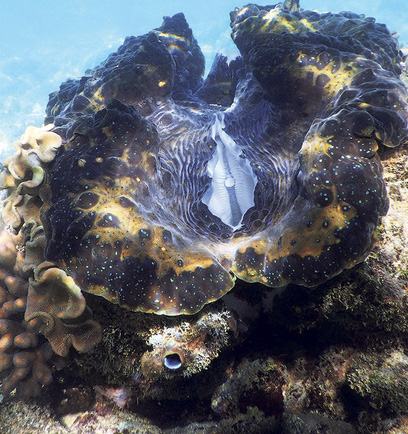Published in the Ocean Watch column, Honolulu Star-Advertiser © Susan Scott
June 18, 2016
BOWEN, Queensland, Australia >> Where fishing is prohibited here in the Great Barrier Reef Marine Park, I can describe the animals in one word: big.
I’ve seen turtles, invertebrates and fish so large I was happy I had Craig beside me as a witness or I would have doubted my own eyes.
One day off a Haslewood Island beach, Craig and I saw in the distance a mound of charcoal-black coral. We had never seen such a coral color and swam toward it. Then the hulk rose up and disappeared into deep water. As the enormous creature departed, we saw, to our astonishment, a pair of giant flippers. We both believe our “coral head” was a leatherback turtle.
 A giant clam about 4 feet long was just one of the oversize
A giant clam about 4 feet long was just one of the oversize
specimens spotted in Australia’s Great Barrier Reef Marine Park.
©2016 Susan Scott
Although leatherback turtles swim off most of Australia’s coasts, no nests have been found here since 1996. Maybe biologists will find a leatherback nest on a Haslewood beach.
In another area of the massive reef in Waite Bay, Craig and I each followed our own marvels and got separated. When I looked up he was barely visible in the distance, but I could see him motioning for me to come see what he found.
This had better be good, I thought, as I swam and swam, because I was passing some eye-popping-beautiful giant clams nestled in beds of corals as stunning as the most exquisite flower gardens.
We later laughed about my worry of missing the clams, because Craig had found the biggest giant clam either of us had ever seen, so old it had its own coral reef growing on its shells. The gaping mother of all clams was, we guessed, 4 feet long. We weren’t far off. The record shell size here is 3.7 feet long.
On another reef we spotted the father of all stingrays (clams seem female; stingrays, male) resting on a sandy patch in a shallow cave of corals. Stingrays aren’t aggressive, but seeing that the ray could escape its space only by swimming toward us, we slowly back-paddled. Never startle a snoozing stingray, especially one as big as an area rug.
And, oh dear, the fish. Schools of huge, rainbow-colored parrotfish roam the reefs. I’ve seen three 3-foot-long humphead wrasses and once found a giant black trevally hanging out under the boat. Even the squirrelfish are supersized, their dark eyes set like jewels against their brilliant red-and-white striped skin.
The weather has been so calm for snorkeling most of the past five weeks that my mask has given me face-ache. But now we’re having a different kind of adventure: knock-down wind. Honu is holed up at the friendly North Queensland Cruising Yacht Club as we wait out rain and impressive blasts of 30-35 knots. But I’m not complaining. On the Great Barrier Reef, even the tradewinds are big.